|
Panasonic Lumix TS2
Finally: Panasonic's shockproof and dustproof 14-megapixel 720p video Lumix now waterproof to 33 feet (by Conrad H. Blickenstorfer; photography by Carol Cotton)
The Lumix TS2 is Panasonic's follow-up on their first waterproof and ruggedized camera, the Lumix TS1. While the new model looks almost identical to the one it replaces, there are some subtle and not so subtle improvements that are certain to elevate Panasonic's standing among manufacturers of waterproof and ruggedized compact cameras. The biggest news for divers is that the new model can now handle depths up to 33 feet, addressing the 10-feet rating that limited the TS1 to just snorkeling. Resolution has been bumped to a full 14.1 megapixel, the camera is more rugged yet, and you can still shoot glorious high definition video to play back on HDTV flatscreens.
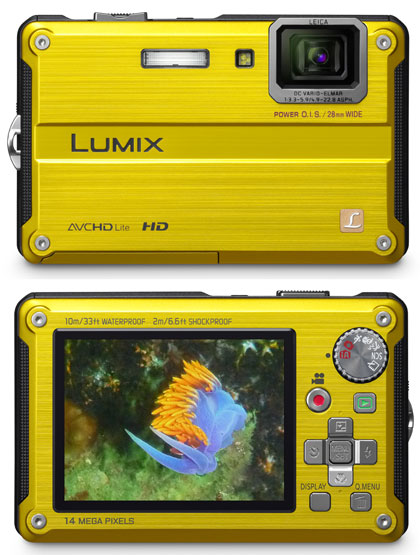
How waterproof/dustproof/shockproof is the TS2?
More than the TS1, which was already pretty tough. Tough and rugged is in, and almost all major manufacturers are now offering some sort of ruggedized and waterproof camera for the great outdoors. But ruggedness comes in various degrees, and customers have different requirements. The TS1 was designed to survive a drop from five feet, to be used underwater at depths of ten feet, and in temperatures between 32 and 104 degrees Fahrenheit. That's pretty tough, but the TS2 can do better. It can now survive a drop from 6.6 feet (two meters), handle depths to 33 feet, and temperatures as low as 14 degrees Fahrenheit. Are these differences meaningful? Absolutely. If you're into winter sports, you can now use the camera in freezing temperatures. If you like the water, it can accompany you now on real dives and not just snorkeling or splashing around. Many dives, of course, are deeper than 33 feet, but not all; many dives on our recent camera eval dive trip off California's Channel Islands were in the 30-40 foot range.
What does Panasonic offer with the LUMIX TS2?
This second Panasonic entry into the waterproof/rugged camera space has a larger 14.1 megapixel sensor, but many other specs remain unchanged. You still get an internal 4.6X optical zoom that starts wide at 28mm equivalent and is augmented by 4X digital magnification. It has several optical image stabilization modes, and you can take movies with sound at 1,280 x 720 pixel resolution, or what in TV speak is known as 720p. You can even use the optical zoom during recording. The camera has most of the features and goodies common to modern digital compacts, such as advanced face recognition (including memorizing faces and making sure they are always properly exposed), predefined scene modes that the camera can select automatically, various advanced autofocus modes, and so on. The bright and crisp 2.7-inch LCD is viewable from almost any angle, and the camera, though it looks identical, is a bit larger, but still small and light enough to fit into almost any pocket.
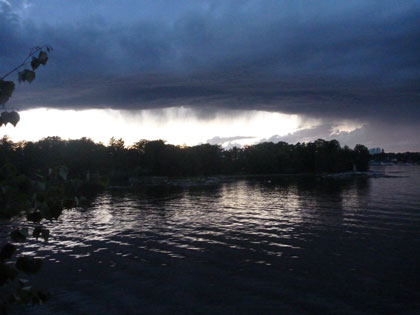
Anyone familiar with one of the Olympus underwater cameras will be instantly familiar with the design and layout of the Lumix TS2. Unlike the roundish Canon D10, Panasonic took a conventional approach with the design and styling of the TS2 that consists of a dark plastic rectangular body with brushed metal front and back bezels. The bezels appear to be held in place with four tough looking exposed Allen screws. Measuring 3.9 x 2.5 x 0.96 inches and weighing 6.5 ounces as tested, the Lumix is (and feels) a bit larger but still not quite as rugged and solid as the Olympus models.
With cameras coming down in price so much, everyone is hustling to differentiate themselves with new and improved features. In the last couple of years, there's been a lot of emphasis on ever more sophisticated face recognition. Panasonic doesn't go totally overboard with face recognition modes, but it will let you register faces of family and friends, and the camera will then try to give familiar faces extra-special treatment.
The TS2 lets you select modes both on its tiny mode wheel and from a scene menu. On the mode wheel you find:
- Auto
- Intelligent auto
- Clipboard (this records maps and other handy texts into the camera's 40MB internal memory)
- Beach & surf
- Snow
- Sports
The TS2 also offers a total of no fewer than 30 shooting modes when the mode wheel is set to "Scene"
- Portrait
- Soft Skin
- Self-Portrait
- Transform (to slim or stretch figures)
- Scenery
- Sports
- Panorama Assist
- Night Portrait
- Night Scenery
- Food
- Party
- Candle Light
- Baby1 (you can set age and name)
- Baby2 (you can set age and name)
- Pet (you can set age and name)
- Sunset
- High sensitivity
- Hi-Speed Burst
- Flash burst
- Starry Sky (shutter speed 15/30/60 seconds)
- Fireworks
- Beach
- Snow
- Aerial Photo
- Pin hole
- Film grain
- Aerial Photo (new for TS2)
- High Dynamic (Standard, Art, B&W; new for TS2)
- Photo Frame (new for TS2)
- Underwater
Depending on the mode, pressing Menu lets you manipulate other settings, like white balance, burst shooting, autofocus mode, recording quality and so on.
The TS2 has optical image stabilization that can be turned on or off. When it is used, it can be in auto mode where the camera decides on the degree of compensation, and there are two always-on modes.
In macro mode you can go as close as two inches, and the cool thing is that macro lets you take sharp pictures all the way from that close to infinity. In most cameras you constantly have to switch back and forth between macro and normal/infinity modes.
Overall, the Lumix TS2 has tons of features and settings. Problem is that you really have to study the manual to figure out what all you have to play with. An even bigger problem is—and I hate to criticize Panasonic again here because it's a universal problem with camera manuals—that the manual is nearly incomprehensible. There are no spelling errors and it's all grammatically correct, but it's all presented in that infuriatingly dull and ugly style used by camera manufacturers everywhere. Though it's all in English, it's almost impossible to read and things often simply don't make sense, or they could be said a whole lot better and more clearly. That is unfortunate, and I hope someone in the camera business will start making useful, readable, attractive manuals. Add to that endless warnings (14 of the 40 pages in the basic instructions are warnings about proper underwater use!) and the instructions are far, far less useful than they should be.
Design and controls
Controls are all to the right of the display. They are logically arranged, with the usual diamond that serves both to navigate menus and to toggle through often used functions (flash, timer, macro, exposure compensation). 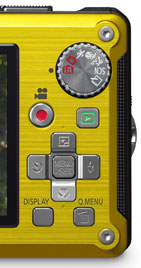 Below the diamond are a button for exposure that toggles through display modes (nothing, grid only, detail still, detail video), and a button to delete pics and select the menu. One thing that's a bit confusing here is that two buttons are labeled "Menu." One is for overall settings and the other is sort of a Quick menu. You get the hang of it, but it isn't immediately obvious which does what. Below the diamond are a button for exposure that toggles through display modes (nothing, grid only, detail still, detail video), and a button to delete pics and select the menu. One thing that's a bit confusing here is that two buttons are labeled "Menu." One is for overall settings and the other is sort of a Quick menu. You get the hang of it, but it isn't immediately obvious which does what.
Above the diamond are separate buttons for video and playback. We like both: having a separate video button means you can start shooting instantly without having to go through setting the camera up for video. A separate playback button lets you quickly check if a pic came out right. You can zoom in at 2/4/8/16X.
A small half-inch diameter mode wheel lets you set the camera into seven different modes. In red are automatic and intelligent automatic mode. In white you can select beach, snow and sport modes as well as documentation mode and access to the full scene modes menu.
On top of the camera is the small and slightly recessed on/off button, the zoom rocker, and the shutter. The zoom rocker is right in front of the shutter, making it possible to operate both with your thumb.
All controls are chrome with either color or embossed symbols and writing. All are tiny and not easy to read even under the best of circumstances.
 The problem with the controls is that while they are standard, they are also very small and potentially difficult to operate in the outdoor conditions this camera was designed for. Even in bright sunshine or with a bit of water on the camera, the symbols become almost impossible to read. Add gloves, as divers are wont to wear in colder water (and skiers and snowboarders do, too), and operating the camera quickly and reliably becomes almost impossible.
The problem with the controls is that while they are standard, they are also very small and potentially difficult to operate in the outdoor conditions this camera was designed for. Even in bright sunshine or with a bit of water on the camera, the symbols become almost impossible to read. Add gloves, as divers are wont to wear in colder water (and skiers and snowboarders do, too), and operating the camera quickly and reliably becomes almost impossible.
The picture below clearly illustrates the problem.
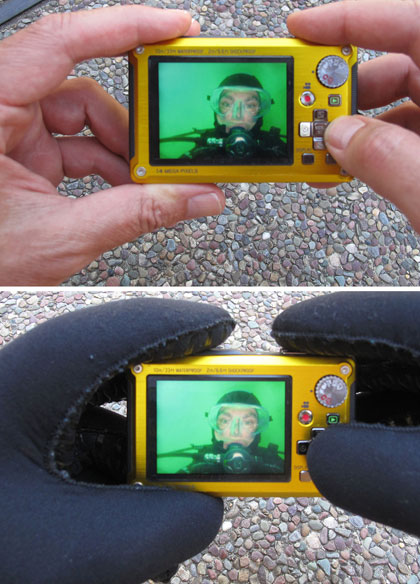
Power
The Lumix TS2 uses a small 940 mAh, 3.6V Li-Ion battery that, however, is up to the job. A full charge is good for a generous 360 pictures, though that depends on how often you use the LCD. The camera comes with a very compact charger that accommodates the battery and plugs directly into the outlet without a cord.
AVCHD Lite versus Motion JPEG
Whenever emerging technology comes into play, things can get tricky. The TS2, like the TS1 before it, can record 1280 x 720 video both in AVCHD Lite format (a designation Panasonic uses to refer to devices capable of recording 720p and not full HD 1080p) and in Motion JPEG. In its settings menu, the camera recommends using AVCHD for playback on a TV and Motion JPEG for playback on PCs or when emailing files. AVCHD records using H.264, uses less space than Motion JPEG, and is also not limited by a 2GB maximum filesize. Problem is that as of now, you can only do playback directly from the camera to a TV or use PHOTOfunSTUDIO 3.0 HD, which has its challenges. Motion JPEG video looked very good.
Waterproof functions
How did Panasonic waterproof the camera and what do you need to observe when using it in the water? At first sight you'd swear this was just an ordinary compact camera. It's always fun to see people's reactions when you take the LUMIX into the water. Everyone thinks you forgot about the camera and it's now destroyed. It isn't, of course, and the LUMIX certainly makes a nice conversation starter in addition to its many other qualities.
There are some telltale differences. Unlike most landlubber cameras with big zoom barrels that motor in and out, the Pana's 4.6X optical zoom is fully internal. That is quite an accomplishment in such a thin camera. Not all underwater cameras do it this way. Canon's competing D10, for example, has a big bulge in front of the camera to accommodate its 3X zoom. It is so big that it blocks part of the flash when shooting macro. The Panasonic doesn't have this problem. The front of the lens is protected by glass (make sure you eliminate droplets when you come out of the water, else pictures can be useless). The battery/storage card compartment and the I/O connector compartment cover doors have O-ring style rubber gaskets and springloaded latches, and there is an extra lever to push and lock things in place. The manual very extensively warns against getting sand or water onto the packing as even a few grains may cause leaks. Also, it is recommended to routinely inspect the seal and have it replaced if it looks compromised, and also once a year. After use underwater, and especially in the sea, the camera should be rinsed off with tap water, or left in a bowl with clean fresh water for ten minutes or so. Do follow those recommendations!
The Panasonic TS2 on a dive trip
To test the TS2 and its newfound scuba talents, we took the camera on a dive trip to the California Channel Islands. We stayed on an 80-foot ship specifically set up for diving. I had hoped Panasonic would be able to also get us the DMW-MCFT2 marine case specifically made for the TS2, but that didn't happen. As it turns out, current and fairly low visibility meant we mainly visited the shallower dive sites around the islands, and several were within the reach of the TS2's 33 foot depth limit.
The water was cold, in the 50s, and so we wore thick wetsuits, hoods and thick gloves. I had misgivings about the thin, non-adjustable wrist strap that comes with the camera, and a heavier and adjustable strap is definitely recommended for diving. Once underwater, the current was so strong that all we could do was hang on to the anchor line.
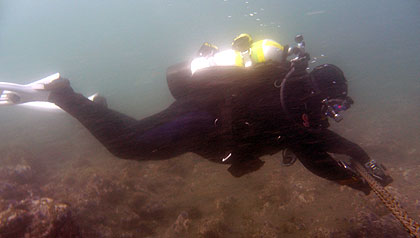
Under these conditions, the tiny controls of the TS2 were a definite problem. They are simply too small and hard to read, and I wonder if the camera's designers have much diving experience. Outdoors and underwater, a tiny control mode wheel with tiny little icons in white and red on silver simply makes no sense at all! Add to that a zoom rocker that is right next to the shutter, and with the dive gloves it was often almost impossible to operate the TS2.
I did see some cool and interesting critters like these Spanish Shawl nudibranchs shown below.
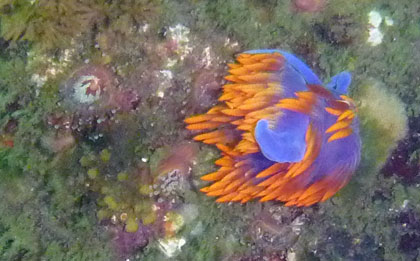
In the strong current, I ran into another problem with the Lumix. Like most waterproof cameras, the TS2 has an underwater mode, but just one. Even in fairly shallow water with decent light, that mode apparently leaves the shutter open so long that pictures do not have a chance to be sharp. Underwater everything moves all the time, and a slow shutter is deadly. Almost none of the pictures of our initial shoot at 25-33 feet was sharp, and so I decided I'd use the sports or automatic mode instead on the next dive.
This actually worked a lot better, with much sharper pictures. However, the problem with using an above-water mode underwater is that there is no color compensation. Underwater you quickly lose red, then orange, then yellow, and so the camera's underwater mode adds those colors back in. I had ample opportunity to practice on the trillion urchins down there and got some good shots. I remembered that the TS1 had a super-easy slider where you can visually adjust the white balance underwater, but didn't get a chance to check for that on the TS2, big gloves and all.
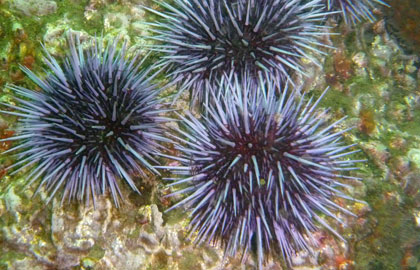
I also found that I prefer a system where there is a normal mode and a macro mode and you can switch between the two. The TS2 lets you use different macro modes in some scene settings, but not in others, so I wasn't always sure how close I could get and still get good pictures. A green or red square tells you whether it's okay or not, but at 30 feet underwater, you can't always see that. As is, in normal recording mode you can set the camera to no macro, AF macro, and zoom macro. In intelligent auto mode, the camera decides what's best, and in most scene modes as well.
Overall, under admittedly perhaps the toughest conditions for any camera, the Lumix TS2 eventually generated a collection of pretty remarkable pictures down there in the kelp forests, currents and rocks, and it's such a compelling little camera that I wished I could pass on my recommendations directly to the product manager -- a few little changes and tweaks, and the TS2 would be great underwater.
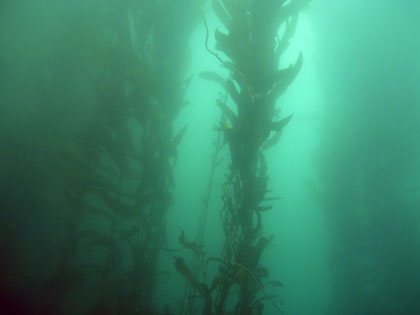
How well did Panasonic hit the mark with this second attempt?
After our extensive testing of the initial Lumix TS1, we found a lot to like, but also had seven recommendations for improvements. Did Panasonic address those with their second underwater camera?
Changed and improved
- 33-foot depth capability. This is huge for divers. Ten feet is fine, but it means a camera is unsuitable for diving. 33 feet is an entirely different story, and there will always be dives shallow enough to take the small and handy TS2 along.
- Tougher. We appreciate the significantly wider temperature range and higher drop spec. The TS2 is now a true outdoor camera that can handle almost any condition. That said, the brushed metal housing and also the screen scratch too easily. Our review sample had seen duty before, and it had quite a few scratches.
- Higher resolution. There are those who feel anything more than 8 or 10 megapixel is wasted. We are not among them and appreciate the TS2's generous 14 megapixel. More megapixel means you can crop and zoom to your heart's content, and make bigger prints.
Still a problem
- Tiny controls and labels. The controls on the TS2 are unchanged from the TS1. They are almost impossible to read or operate under difficult viewing conditions or with gloves. An outdoors camera should have outdoors controls.
- Multiple video modes. All the numerous video modes with their different compressions and file formats is far too confusing. Decide on what is best for a camera like this and make it the default.
- Manual!. The less said the better. Writing a decent, informative manual is not an insurmountable task.
- Non-standard controls. Having the zoom and shutter right next to each other makes them almost impossible to use under difficult conditions.
Other commentary...
- Quality pictures. Panasonic isn't a traditional camera company, but their line of Lumix cameras has steadily improved over the years to an extent where they are now among the very best. This also shows in the TS2. While we never judge underwater cameras on minute image quality details alone, this Lumix takes good pictures both above water and below.
- Bright LCD. The very bright 2.7-inch hi-res display and a wide viewing angle is a good choice for an outdoor and underwater camera, and the LCD brightness booster is much appreciated. However, LCD size and resolution are unchanged from the TS1, and no longer state-of-the-art.
- Underwater shooting mode. Panasonic gave the TS2 an underwater shooting mode as well as a special underwater white balance feature. This is important as taking pictures underwater is VERY different from shooting on dry land. Water progressively filters out certain colors and there's also a lot of stuff floating around, making it very difficult for the camera to focus. Good underwater modes and special white balance settings can make for much better pictures underwater.
- Underwater case.
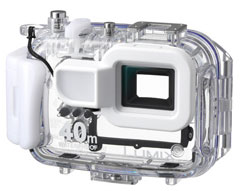 A waterproof camera with underwater modes practically begs for an optional underwater case, and Panasonic offers one. The DMW-MCFT2 marine case for the Lumix TS2 can handle depths up to 130 feet, which is the depth limit for recreational diving. A waterproof camera with underwater modes practically begs for an optional underwater case, and Panasonic offers one. The DMW-MCFT2 marine case for the Lumix TS2 can handle depths up to 130 feet, which is the depth limit for recreational diving.
- Wide angle zoom. It's always good to have a zoom that starts slightly wide (you can get closer to subjects indoors, and you get more into the picture in tight places), that is especially so underwater. Panasonic's choice of a 28-128mm equivalent is just perfect.
- HD video. Simply put, VGA video is out, passee, last decade. It's good to see Panasonic give its first waterproof camera glorious 1280 x 720 high definition video. Now just ditch the old stuff.
Bottom line
The 14-megapixel Lumix TS2—available in silver, blue, yellow or orange—is Panasonic's second entry into the waterproof/rugged camera space where it joins offerings from the likes of Olympus, Pentax, Fuji, Canon and a number of specialty manufacturers. 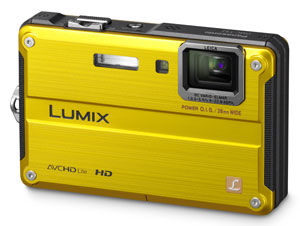 The nicely styled camera is a bit large but well equipped to handle much of the abuse it may encounter outdoors. It can be used in freezing temperatures (down to 14 degrees Fahrenheit), it is dust and waterproof, and it can handle being dropped from up to 6.6 feet. The nicely styled camera is a bit large but well equipped to handle much of the abuse it may encounter outdoors. It can be used in freezing temperatures (down to 14 degrees Fahrenheit), it is dust and waterproof, and it can handle being dropped from up to 6.6 feet.
A much enhanced 33-foot depth limit makes the TS2 suitable for many dives, and snorkelers and boaters, as well as anyone who loves to hang out in and around water, will also greatly enjoy this camera.
The TS2 has a bright and vibrant 2.7-inch LCD display that is large enough and can be seen from any angle. The camera's controls are still much too small and have tiny, hard-to-read icons and labels. The 28-128mm equivalent 4.8X optical zoom is perfect for underwater use where wide angle shooting is almost mandatory. The zoom is still located right next to the shutter—not optimal for shooting in difficult conditions.
The camera has numerous settings, scene and shooting modes and other features. 1280 x 720 video recording quality is excellent. The list price of US$399 is high compared to the rugged/waterproof competition.
The Lumix TS2 is a much more useful outdoors camera than the TS1 was and it's capable of taking very good pictures and (once you know your way around) offers good control, but Panasonic's second effort is still hampered by its delicate controls and could benefit from a more complete hardware and software adaptation to the harsh realities of outdoor use.
|










